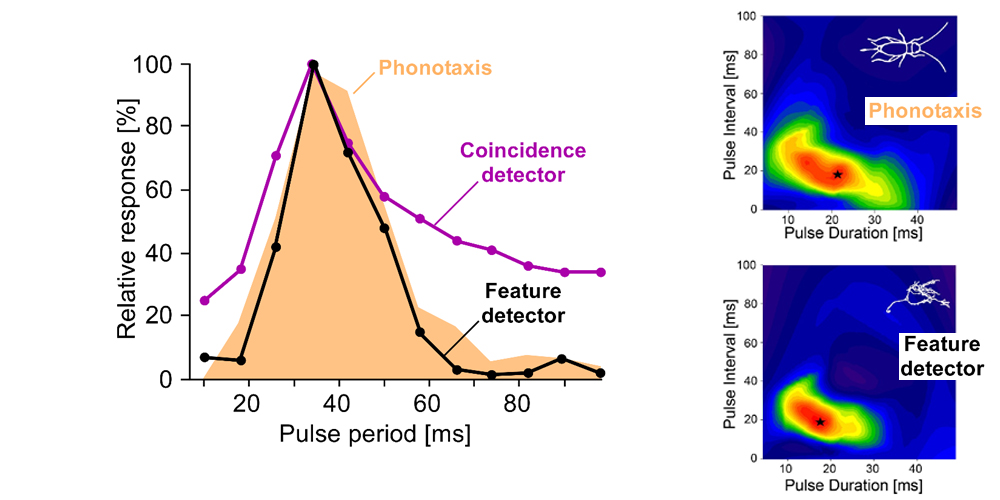Auditory Pattern Recognition
The Fundamental Problem |
|
Using acoustic signals for communication requires at the receiver side hearing organs that detect the signals and neural processing mechanisms that specifically identify the features of the signals. How are such neuronal mechanisms organised and what can insects contribute to understand such mechanisms? Insects with their simple nervous systems offer the chance to analyse auditory processing at the level of identified neurons and to relate the response properties of the neurons to the tuning of the animal's behaviour. We aim to find such neurons in the cricket brain and to relate their function to the pattern recognition process, to understand the neuronal basis of acoustic communication, as pointed out by M. Konishi.
Konishi on analysis of sensory systems (top) and outline of song pattern recognition in crickets (bottom).
What kind of mechanism could the females use to recognize the stereotypical pulse pattern of the male calling song? An early hypothesis indicated a delay-line and coincidence detector mechanisms, in which an internal delay matches the period of the pulse pattern. As a coincidence detector processes the direct and delayed signal, only pulse periods which match the duration of the internal delay will give a proper response. These will be detected by a subsequent feature detector.

Tuning of cricket phonotactic behaviour and of auditory brain neurons reveals a close match and indicates that these neurons are crucial for the pattern recognition process.
Neural Basis of Pattern Recognition in Crickets |
|
We identified the compnents of such a circuit in the cricket brain, with a delay-line, a coincidence detector and a feature detector neuron. For example, a non-spiking interneuron, responds with a hyperpolarisation to each sound pulse and then generates a post-inhibitory rebound that matches the timing of the pulse pattern. This delayed activity coincides with the direct spike activity of an ascending interneuron and leads to the very specific response of feature detecting neurons – the “grandmother cells” for cricket auditory behaviour? This is an exciting field, and we now aim to link pattern recognition with the motor control of phonotactic behaviour.
Non-spiking interneuron in the anterior cricket brain, whole mount (left) and details (right). The neuron responds to a sequence of sound pulses with an inhibition followed by a delayed excitation (inset). It forms the delay-line in the pattern recognition network.
References:
- Hedwig B (2016) Sequential Filtering Processes Shape Feature Detection in Crickets: A Framework for Song Pattern Recognition, Frontiers in Physiology, doi: 10.3389/fphys.2016.00046
- Schöneich S, Kostarakos K and Hedwig B (2015) An Auditory Feature Detection Circuit for Sound Pattern Recognition. Sci Adv 1(8) e1500325, doi: 10.1126/sciadv.1500325
- Kostarakos K and Hedwig B (2015) Pattern recognition in field crickets: Concepts and neural evidence. J Comp Physiol A, 201:73-85, doi 10.1007/s00359-014-0949-4
- Kostarakos K and Hedwig B (2012) Calling song recognition in female crickets: Temporal tuning of identified brain neurons matches behaviour. J Neuroscience 32:9601-9612

